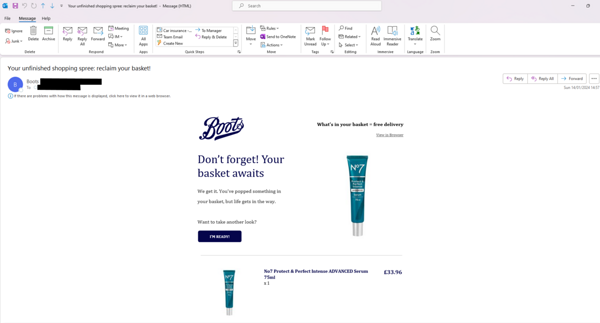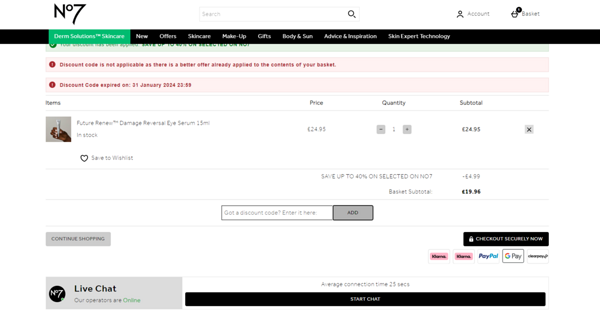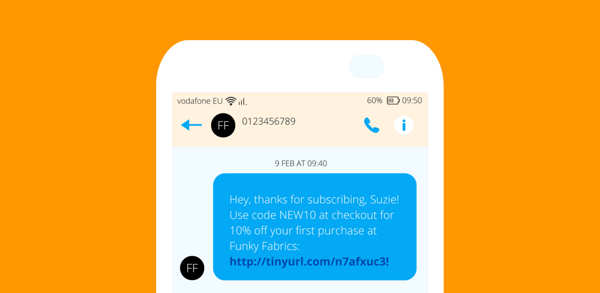Like any business, eCommerce brands must measure performance to ensure that chosen sales and marketing tactics are worth investing in – and to identify where improvements can be made.
Performance can be monitored and evaluated using a range of eCommerce metrics and KPIs. This article explores 24 different metrics, their significance for eCommerce businesses and how to record, calculate, monitor and improve them.
1. Conversion rate
Conversion rate measures the rate at which leads or web visitors complete a desired action, such as making a purchase, signing up for a service or downloading a file.
Formula: conversions (C) / total leads (TL) x 100 = conversion rate (CR)
Why is conversion rate important?
Conversion rate is a useful marketing metric because it tells you about campaign success. The higher the CR, the more effective your campaign has been.
How to improve your conversion rate:
Prioritise good website design and usability.
Optimise landing page(s) and checkout process with strong call-to-actions.
Conduct A/B testing on elements throughout your sales funnel.
2. Customer acquisition cost
Customer acquisition cost is the amount of marketing spend needed to acquire a new customer. The lower your customer acquisition cost, the better.
Formula: spend (S) / no. of newly acquired customers (C) x 100 = customer acquisition cost (CAC)
Why is customer acquisition cost important?
Advertising costs affect your bottom line, so it's vital to know how much you're spending – and whether yuor activities are worth the investment.
How to reduce customer acquisition costs:
Use cost-effective and organic marketing channels that customers prefer.
Focus on customer retention.
Increase your conversion rate to bump up new customer numbers.
3. Cart abandonment rate
This metric measures the rate at which customers add items to their online shopping cart but don't make it through the checkout process.
Formula: no. of completed transactions / no. of shopping carts created x 100 = cart abandonment rate
Why is cart abandonment rate important?
A high cart abandonment rate indicates a problem. It could be that your website offers a poor user experience, your sales funnel is broken, or there are issues with products or pricing.
How to reduce cart abandonment rate:
Send abandoned cart reminders to tempt would-be shoppers back to your store.
Don't force interested buyers to create an account; offer guest checkout.
Check your eCommerce store works as it should.
4. Checkout conversion rate
Checkout conversion rate refers to the percentage of online shoppers that go through the checkout process from start to finish.
Formula: completed checkouts (CC) / total store visitors (TSV) x 100 = checkout conversion rate (CCR)
Why is checkout conversion rate important?
Checkout conversion rate shows how many interested buyers go on to become customers. It's a valuable metric to monitor over time – if you can increase it, you'll see a spike in revenue.
How to increase checkout conversion rate:
Focus on reducing cart abandonment.
Provide multiple payment options, such as text payments, credit cards or cash-on-delivery.
Use a single checkout page to decrease friction.
5. Return rate
Return rate measures the percentage of orders returned by customers.
Formula: no. products returned (R) / no. products sold (S) x 100 = return rate (RR)
Why is return rate important?
A high eCommerce return rate is bad news – not only are returns costly as they impact profit margins, but they also don't help with brand perception and customer retention.
How to reduce your return rate:
Focus on product quality control to check items are in perfect condition before posting.
Use high-quality product photos and accurate descriptions so customers fully understand what they're buying.
Use robust (but not wasteful) packaging to help avoid damage in transit.
6. Return costs
This metric measures the actual cost of product returns to your eCommerce business.
Formula: n/a
There's no set formula, as return costs can incorporate cycle time, reverse shipping costs, lost commissions, reselling costs, and more. This article explains.
Why are return costs important?
Returns are a direct cost to your business and wreak havoc on your bottom line.
How to reduce return costs:
Use aggregated shipping (multiple items in one container) where possible.
Deploy automation software to handle returns efficiently and recover their maximum value.
Ensure an easy returns experience for the customer (they'll be more likely to buy again).
7. Repeat purchase rate
Repeat purchase rate measures the percentage of customers who return to your store to buy again. It's also known as re-order rate and repeat customer rate.
Formula: no. repeat customers (RC) / total no. customers (TC) x 100 = repeat purchase rate (RP)
Tip: if you use Shopify, an app like this will help you calculate repeat purchase rates.
Why is repeat purchase rate important?
Repeat customers are loyal customers. By focusing on them, you can grow revenue while saving on new customer acquisition costs.
How to improve your repeat purchase rate:
Implement a loyalty program with rewards for repeat customers.
Offer personalised recommendations to encourage more sales.
Launch a subscription-based business model if you sell consumable products.
8. Customer lifetime value
Customer lifetime value relates to the total worth a customer brings to your business throughout your relationship with them. The formula for this metric is twofold:
Formula: average purchase value (APV) x average no. purchases (AP) = customer value (CV)
customer value (CV) x average customer lifespan (ACL) = customer lifetime value (CLV)
This online CLV calculator could help you work it out easily.
Why is customer lifetime value important?
This metric measures customer loyalty. It can be used to maximise customer value, aid customer segmentation, and evaluate marketing effectiveness and product or service quality.
How to increase customer lifetime value:
Implement customer retention strategies like a loyalty program and personalised experiences.
Upsell and cross-sell related products or services.
Build a customer community.
9. Purchase frequency
Purchase frequency measures the number of times customers purchase from you within a specific time frame. The higher the rate, the better.
Formula: total no. orders / no. unique customers x 100 = purchase frequency (PF)
Why is purchase frequency important?
Understanding purchase frequency will help you determine how loyal and engaged customers are. You can then target specific groups of already loyal customers to nurture them further.
How to increase purchase frequency:
Promote frequent ordering through special discounts, text coupons and flash sales. (And extend these promotions for repeat customers.)
Learn loyal customers' buying habits using data insights.
Allow customers to request reminders to reorder products.
10. Average order value
Average order value is the amount of money customers spend per transaction over a particular time period.
Formula: total revenue (TV) / no. orders = average order value (AOV)
Why is average order value important?
Increasing your average order value will increase revenue (and hopefully profit as long as you choose the right strategies for upselling).
How to increase average order value:
Focus on selling higher-value items with a strong profit margin.
Offer special promotions, e.g. free shipping, for customers with order values over a set threshold.
Suggest product bundles and kits.
11. Inventory turnover rate
This metric reflects how often you sell or replace your inventory over a specific period. It tells you which items are flying off the shelf and which aren't.
Formula: cost of goods sold (COGS) / average inventory value (AIV) = inventory turnover rate (IT)
Take the inventory value at the start of the time period and add it to the inventory value at the end, then divide it by two to get the average inventory value.
Why is inventory turnover rate important?
A high inventory turnover rate indicates strong sales, whereas a low rate suggests weak sales or decreased market demand. It also tells you whether you're keeping too much inventory in stock and if you’re producing orders fast enough.
How to improve inventory turnover rate
Optimise your supply chain so you don't have excessive stock waiting around.
Predict future sales through demand forecasting.
Ensure products are accurately valued, taking into account raw materials, production and staffing costs.
12. Stockout rate
Stockout rate is used to measure the percentage of products that aren't available in your inventory when customers place an order online.
Formula: unavailable stock-keeping units (SKUs) / total available SKUs = stockout rate (SR)
Why is stockout rate important?
A high stockout rate indicates service failure, which can negatively affect customer satisfaction and loyalty. It can also lead to poor sales forecasting and make marketing efforts less effective.
How to improve stockout rate:
Ensure inventory data is always up-to-date.
Use robust inventory management software.
Carry a good (but not excessive) amount of safety stock.
13. Sell-through rate
Your sell-through rate measures the percentage of inventory you've sold to customers over a specific time period in relation to the amount of inventory shipped to your warehouse.
Formula: total sales (TS) / stock in hand (SH) x 100 = sell-through rate (STR)
Why is sell-through rate important?
Sell-through rate helps you track sales data against your target so you can adjust your sales, marketing and inventory management strategy accordingly. It'll also tell you which products are selling well.
How can you improve your sell-through rate:
Replace slow-selling products from your inventory with more popular ones.
Include slow-selling items in bundles to shift surplus inventory quickly.
Focus on marketing to increase the visibility of your store.
14. Lead time
In an eCommerce context, lead time means the length of time it takes from placing an order with a manufacturer or supplier to when it's received in your warehouse.
Formula: order delivery date (ODD) - order request date (ORD) = lead time (LT)
Why is lead time important?
Lead time is crucial to inventory control and supply chain management. Measuring it can help you anticipate delays and ensure on-time deliveries to customers.
How to shorten lead time:
Consider placing smaller orders regularly rather than a bulk order periodically.
Manage inventory accurately using dedicated software.
Build positive relationships with suppliers.
15. SKU productivity
SKU productivity tracks the performance of each individual product in your shop to help you determine which performs the best and worst. The easiest and most accurate way to track SKU productivity is via inventory management software that provides automated calculations. But here's the basic formula below.
Formula: total no. SKUs in a range / total no. SKUs x 100 = SKU productivity rate
Why is SKU productivity important?
By tracking SKU productivity, you can identify underperforming products and recognise which ones are dragging your profits down.
How to improve SKU productivity:
Use alternative sales and marketing channels to start moving underperforming products.
Include such products in bundles to save on shipping fees.
Do an advanced SKU analysis.
16. Cost per acquisition
A key marketing metric, cost per acquisition (CPA) tells you how much it costs (in marketing spend) to reach and convert a new customer. Ideally, your CPA should be as low as possible.
Formula: total campaign cost (TC) / no. conversions (C) = cost per acquisition (CPA)
Why is cost per acquisition important?
Knowing which marketing campaigns are the most effective is essential so you don't waste money. CPA measures not only this but also the revenue generated as a result.
How to reduce CPA costs:
Provide personalised marketing experiences (they're more effective).
Optimise campaign landing pages and include strong call-to-actions.
Make the checkout process as frictionless as possible.
17. Time to first purchase
Time to first purchase shows you how long it takes for interested buyers to convert into first-time customers after interacting with your business, i.e., by visiting your website or responding to a marketing campaign.
Formula: = SUM (date of first purchase - date of interaction) / total new customers = average time to first purchase (ATFP)
A good way to measure this metric is to use Google Analytics eCommerce tracking reports, which can tell you about visitor session times and conversion events.
Why is time to purchase important?
This eCommerce metric helps you understand customer behaviours and can inform future marketing campaigns. For example, if you notice that customers tend to buy particular products after their fourth or fifth visit to your store, this suggests they need more information before they decide to buy.
How to improve time to purchase:
Conduct effective onboarding campaigns.
Use tempting incentives such as a generous first-time customer discount.
Nail your introductory interaction with leads.
18. Monthly recurring revenue
Monthly recurring revenue measures the amount of predictable recurring income generated by customers who've subscribed to receive repeat orders from your store.
Formula: no. customers (C) x avg. monthly revenue per customer (AMRC) = monthly recurring revenue (MRR)
Why is monthly recurring revenue important?
If you use a subscription-based business model, measuring MRR will help you predict future revenue and identify growth opportunities. You'll also see if you're losing customers and can react to problems accordingly.
How to increase monthly recurring revenue:
Get subscription pricing right through market research or A/B testing.
Upsell other subscription-based products.
Focus on acquiring new recurring customers.
19. Average revenue per user
This metric indicates the average revenue generated from each of your customers (users) over a specific period.
Formula: revenue generated / no. customers = average revenue per user (ARPU)
Why is average revenue per user important?
ARPU will help you identify the lowest and highest-value customers. You can then segment these groups and deliver personalised marketing aimed at driving growth.
How to increase ARPU:
Use customer retention strategies to extract more value from existing customers.
Build a better product discovery experience.
Create a customer persona for high-value customers to aid with personalised marketing efforts.
20. Revenue per visit
Revenue per visit is a website traffic metric that tells you how much monetary value each visitor to your online store generates. You can use this if you already measure conversion rates and average order value.
Formula: conversion rate (CR) x average order value (AOV) = revenue per visit (RPV)
Why is revenue per visit important?
This metric gives you deeper insights into your online store's performance as it tells you how much money you're making from each visitor. A high RPV is great news - it also means conversion rates and AOV are high.
How to increase RPV:
Provide an excellent, personalised user experience on your website.
Send highly targeted marketing campaigns.
Focus on getting shoppers to buy more from your store in a single purchase.
21. Retention rate
Retention rate is the percentage of customers who come back to your store to make either one or more repeat purchases. You need three pieces of information to calculate this metric:
No. of customers at the start of your time period (S)
No. of customers at the end (E)
No. of new customers acquired during the time period (N)
Formula: [(E-N)/S] x 100 = CRR= retention rate (RR)
Why is retention rate important?
Loyal customers are the best type to have. They make several orders during the relationship lifetime, costing less to keep than attracting new customers. So, the higher your retention rate, the better.
How to increase retention rate:
Gather feedback and try to exceed customer expectations to increase customer satisfaction
Send targeted, personalised communications to improve the customer experience.
Provide high-value products or services.
22. Referral rate
This metric measures a marketing tactic where new customers are referred to your store via existing customers who act as advocates for your brand.
Formula: referred customers (RC) x total customers (TC) x 100 = referral rate (RR)
Why is referral rate important?
Referral rates tell you how effective your referral programme is in generating new customers. It also gives you a measure of brand trust and customer satisfaction.
How to increase your referral rate:
Ensure your referral programme offers lucrative benefits for existing customers.
Also incentivise new customers who come through a referral.
Make your referral programme sharable.
23. Average response time
Average response time is a metric used in customer service. It tracks the length of time it takes your eCommerce business to respond to customer enquiries or help requests.
Formula: total time taken to respond (TTR) / total no. enquiries (TE) x 100 = average response time (ART)
Why is average response time important?
Customers don't like to wait around to get answers to their questions – they'll feel dissatisfied and may even head off to a competitor.
How to reduce average response time:
Set up automated responses and chatbots for common queries so customers receive a message immediately.
Invest in excellent training for your customer support team.
Use an omnichannel solution to manage floods of conversations across different channels.
24. First contact resolution rate
This metric that measures the percentage of customer enquiries that are solved during the first contact with your business.
Formula: no. issues resolved on first contact (IFC) / total no. issues (TI) x 100 = first contact resolution rate (FCR)
Why is first contact resolution rate important?
Solving issues via the first contact means a) your customers are likely to be happy, and b) your team are doing a great job at customer service.
How to increase your first contact resolution rate:
Train your customer team so they fully understand your products or services.
Implement a customer service knowledge base.
Use a CRM so all support staff can access customer information and previous history.
Why you should regularly track eCommerce metrics and KPIs
Consistently tracking eCommerce metrics and KPIs helps you monitor store performance so you can improve it. This will ensure operational efficiency so you only spend time and effort on the areas that serve your business best.
Through monitoring performance, you'll also have the data at your fingertips to solve problems effectively and make better strategic decisions. Ultimately, tracking these metrics will lead to a much-improved customer experience over time – and maximum sales.
How often should you track KPIs?
Not all KPIs and key metrics have to be measured or calculated each day, week or month. Messente's Marcus Kallavus, Head of Revenue, explains: "Some metrics change rapidly and can be monitored in real-time – for example, you can check your stockout rate at any time in just a few clicks if you use inventory management software. You might need to know this on a daily basis so you can plan when to top up your inventory."
Other metrics can and should be calculated over a longer period, such as your retention rate. A shift in this metric will only become apparent after a set amount of time has gone by, such as six months or a year.
Use eCommerce metrics to boost your store's growth
Measuring the performance of your eCommerce business will give you vital information needed to grow your customer base and increase sales.
There are tons of metrics and KPIs you could use to do this, but it's worth choosing between three and five to begin with – the ones that most align with your business goals. So if a key objective is to improve customer satisfaction, focus on retention rates, referral rates and first contact resolution rates.
Fast and direct communication is key to improving customer satisfaction and relationships. Consider using Messente's SMS API to get your messages into customers' hands right away. It can be used for promotional campaigns, transactional alerts and one-to-one customer service chats. And you can easily measure the success of your communications with Messente's easy-to-use analytics and reporting tools.
Discover Messente's business texting service for eCommerce brands today.









